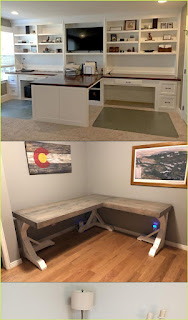Smart Storage Woodworking Plans for a Clutter-Free Shop
A well-organized woodworking shop is not merely aesthetically pleasing; it is a crucial element for efficient and safe work practices. Clutter impedes workflow, increases the risk of accidents, and ultimately diminishes the enjoyment of the craft. This article presents comprehensive woodworking plans for implementing smart storage solutions, transforming your chaotic shop into a streamlined and productive workspace.
Assessing Your Needs and Space
Before embarking on any construction, a thorough assessment of your shop's layout and storage requirements is paramount. This involves a detailed inventory of your tools and materials, considering their size, weight, and frequency of use. Accurate measurements of your available space are equally vital, ensuring optimal utilization of every square foot. Consider factors such as ceiling height, wall space, and floor area. Sketching a preliminary layout on paper or using digital design software can greatly assist in planning efficient storage solutions.
Categorizing Tools and Materials
Effective storage hinges on efficient categorization. Group similar items together – hand tools, power tools, fasteners, lumber, and finishing supplies, for instance. This logical arrangement streamlines retrieval and minimizes search time. Consider the frequency of use when assigning storage locations; frequently used items should be easily accessible, while less frequently used tools can be stored in less convenient but equally secure locations.
Measuring and Planning
Precise measurements are fundamental to successful woodworking projects, and storage solutions are no exception. Accurately measure the dimensions of your tools and materials to determine the appropriate size of storage units. Account for clearances and accessibility – ample space around storage units is crucial for safe and efficient movement within the shop. Factor in the weight of stored items, ensuring that shelving and other storage structures are adequately robust to support the load.
Building Essential Storage Components
This section outlines the construction of various smart storage components, providing detailed plans and considerations for each.
Wall-Mounted Storage Cabinets
Wall-mounted cabinets offer exceptional space-saving capabilities, maximizing vertical space utilization. Construction typically involves building sturdy frames from lumber, incorporating adjustable shelves for adaptability. Consider incorporating features such as drawers for smaller tools and compartments for specific items. Use high-quality hinges and latches to ensure cabinet durability and secure closure. Always securely fasten cabinets to wall studs to prevent accidental toppling.
Materials: Select high-quality lumber such as maple, birch, or plywood for cabinet construction. Consider using pre-finished lumber or applying a durable finish for protection and aesthetics.
Tools: The necessary tools include a table saw, miter saw, drill press, router (optional), and various hand tools. Appropriate fasteners such as screws and wood glue are also essential.
Rolling Tool Chests and Cabinets
Rolling tool chests and cabinets provide mobility and versatility, allowing for easy relocation of frequently used tools. These can be constructed using similar techniques to wall-mounted cabinets, incorporating heavy-duty casters for smooth movement. Consider incorporating locking mechanisms for security and drawer dividers for organized storage of smaller tools.
Materials: Choose durable materials capable of bearing significant weight, such as plywood or hardwood. Select high-quality casters with a sufficient load capacity.
Tools: Similar tools are required as for wall-mounted cabinets, with the addition of tools for attaching casters.
Overhead Storage Racks
Overhead storage racks are ideal for storing less frequently used items, maximizing floor space. Construction typically involves building a sturdy frame from lumber or steel, ensuring secure attachment to ceiling joists or support beams. Consider the weight capacity when choosing materials and fasteners. Use caution when accessing overhead storage to prevent accidents.
Materials: Steel framing offers superior strength for heavy items; however, robust lumber is also viable for lighter loads. Use appropriate fasteners for secure attachment.
Tools: Tools include a drill, wrench, level, and measuring tape. Additional tools may be required depending on the chosen materials and design.
Specialized Storage Solutions
Consider specialized storage solutions tailored to your specific needs. Examples include:
- Dowel racks: for organizing dowels and other cylindrical materials.
- Pegboard systems: for hanging tools and small equipment.
- Bin systems: for storing screws, nails, and other small parts.
- Custom-built lumber racks: for efficient lumber storage to maximize lumber lifespan.
- Hanging organizers for clamps and sanding blocks: keep frequently used tools accessible and within easy reach.
Material Selection and Finishing
The choice of materials significantly impacts the durability and longevity of your storage solutions. Hardwoods such as maple, birch, and cherry offer superior strength and aesthetic appeal but are more expensive. Plywood provides a cost-effective alternative with good strength and stability. MDF (Medium-Density Fiberboard) is a less expensive option but is less durable and more susceptible to moisture damage. Always select materials appropriate for the intended load capacity and environmental conditions.
Appropriate finishing is crucial for protecting your storage units from moisture and wear. Oil-based finishes provide excellent durability and water resistance. Water-based finishes offer lower VOCs (volatile organic compounds) and are easier to clean up. Consider applying several coats for maximum protection. Properly sanded surfaces ensure a smooth and even finish.
Safety Considerations
Safety is paramount when designing and constructing storage solutions. Ensure that all units are securely fastened to prevent toppling. Avoid overloading shelves and racks. Use appropriate lifting techniques when handling heavy items. Consider incorporating safety features such as locking mechanisms for cabinets and drawers, especially those containing sharp tools or hazardous materials. Adequate lighting is crucial for safe navigation within the shop, especially in areas with overhead storage.
Conclusion
Implementing smart storage solutions significantly enhances the efficiency, safety, and enjoyment of your woodworking shop. By carefully assessing your needs, designing appropriate storage components, and selecting high-quality materials, you can create a clutter-free and productive workspace. Remember to prioritize safety throughout the design and construction process. A well-organized shop not only facilitates efficient workflow but also contributes to a more enjoyable and rewarding woodworking experience.









